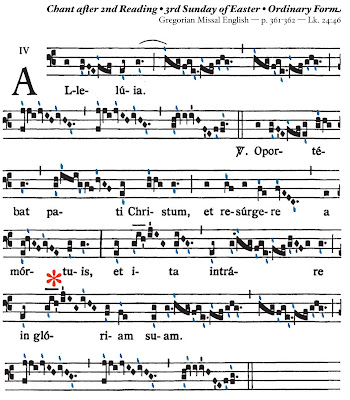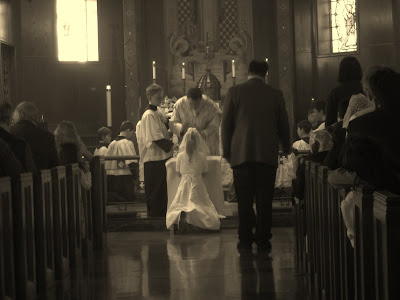It was necessary that Christ suffer, and rise from the dead, and so enter into His glory. (Luke 24:46)
This Sunday's Second Alleluia is taken from St. Luke's Gospel, an embellishment of the parting words of Jesus before He ascends into Heaven. Just as this explanation must have alternately mystified and cheered the disciples, so this Alleluia exemplifies the difficult passage from suffering into glory.
In the image above, the ictus marks are in blue, marking the notes which receive rhythmic emphasis. I marked the thematic climax with a red asterisk over the word gloriam, which seems to me to be the culmination of the verse, although the words oportebat (it was necessary) pati (to suffer) and ita (so) are also strong points in the melody.
There are a number of repeated motifs in this unusual Alleluia which are accomplished through the use of the porrectus and climacus. The idea of suffering is said to be represented in the first half of the jubilus of the Alleluia while the second half of the jubilus demonstrates Christ's coming into glory after His passion.
The porrectus is found five times in the first line of the Alleluia below:
The five consecutive porrectus in this line suggest a sense of struggle, of oppression, since the melody can not soar and must remain locked in place since the melody descends one note and returns to the original position:
 |
| porrectus |
However, in the second half of the jubilus, we see dramatic leaps and cascades, symbolizing joy. The cascade effect is largely effected by the artful use of the climacus, a series of three or more descending notes, four of which are circled here:
The climacus is usually found in groups of three, and for some reason I often rush these, I think because it reminds me of a triplet, which in classical music is sometimes found in place of a quarter note. The notes in a triplet are a bit faster than eighth notes but slower than sixteenth notes. I usually circle these so I remember to give each note equal value. In the case above, each climacus begins with a stressed note, so the next two diamond-shaped notes are sung more lightly.
 |
| climacus |
While searching for a picture of the climacus, I discovered that there was a 7th c. Greek monk named St. John Climacus, or St. John the Ladder, based on the fact that he wrote a book called The Ladder of Divine Ascent which quickly became one of the most widely read and beloved treatises on Byzantine spirituality.
Perhaps this picture of St. John Climacus leading a group of saints up the ladder to heaven will help you, as it does me, to remember the name of this Gregorian chant neum.


















